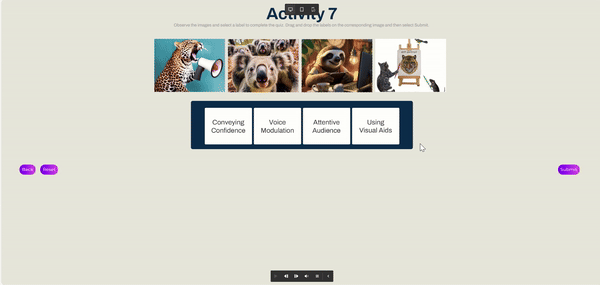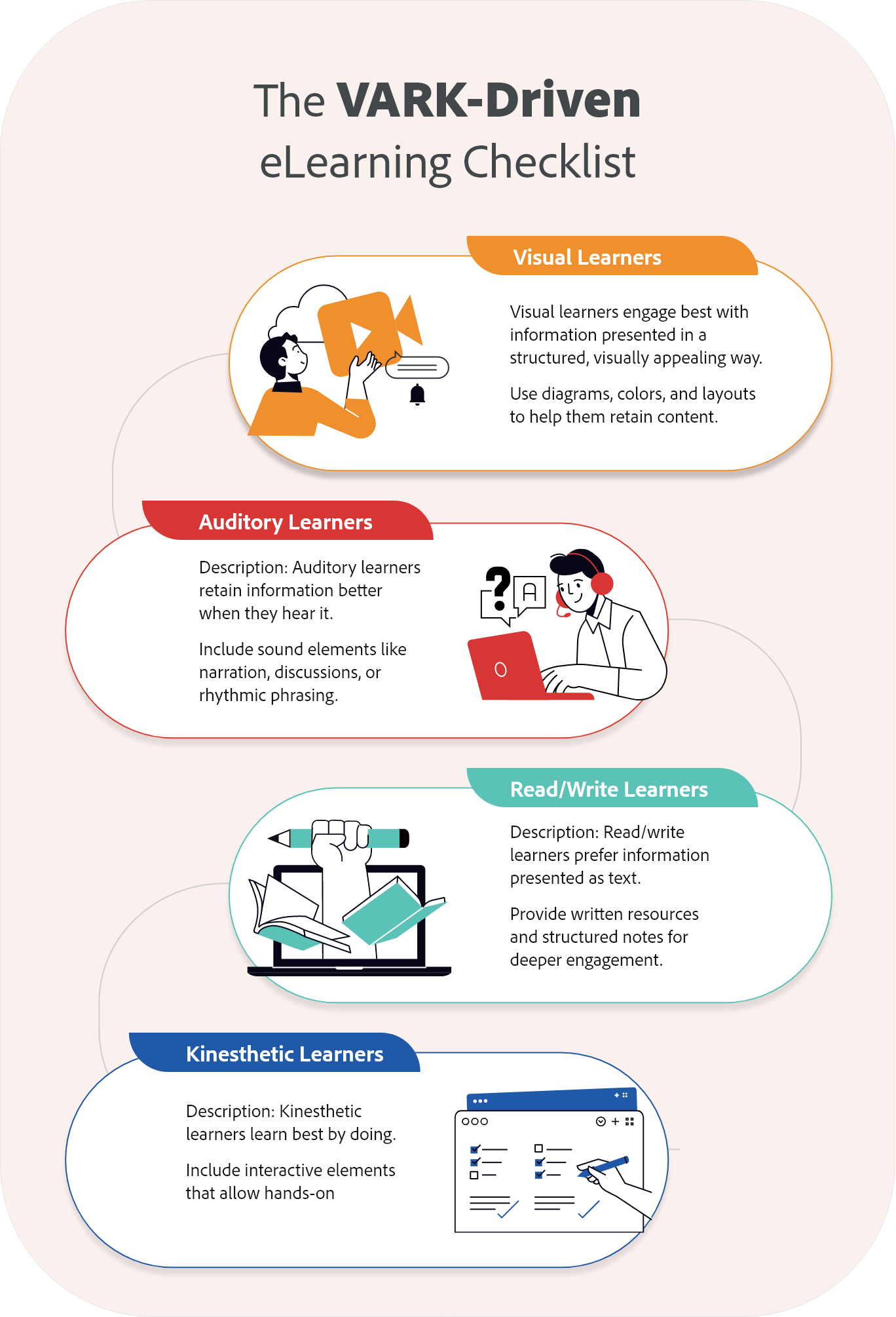Introduction
In eLearning, each learner is exclusive. The VARK mannequin—Visible, Auditory, Learn/Write, and Kinesthetics studying kinds—developed by Neil Fleming, an Academic Marketing consultant, helps us design programs that cater to particular person preferences, enhancing engagement and retention. By making use of VARK, we create personalised, efficient studying experiences that meet numerous wants and enrich studying outcomes.
Let’s dive into every of the VARK kinds and discover how we will combine them into our eLearning modules to make sure each learner finds the content material participating and simple to soak up.
Visible Learners: The Energy of Imagery
Visible learners, roughly 30% of the inhabitants, based on a research by Muneera Spence (2006), excel when info is introduced visually via photographs, diagrams, and spatial layouts. They’re significantly drawn to colours, patterns, and arranged constructions that make clear ideas.To help them in eLearning:
- Use Diagrams and Charts: Exchange prolonged textual content with flowcharts, infographics, and thoughts maps.
- Embrace Movies and Animations: Visible steps simplify advanced concepts.
- Add Icons and Shade-Coding: Highlights key factors and sections, aiding navigation.
- Set up Layouts Thoughtfully: Whitespace and clear construction forestall litter.
These parts make programs participating, serving to visible learners retain info effortlessly.

Auditory Learners: Studying Via Sound
Auditory learners, about 25% of the inhabitants, based on a research by Muneera Spence (2006) take up info greatest by listening to it, typically recalling tone, rhythm, and inflection.
Right here’s the way to make programs auditory-friendly:
- Narrated Content material: Pair textual content or animations with audio narration for simpler processing.
- Podcasts/Audio Lectures: Embrace an audio library with key ideas defined in depth.
- Dialogue-Primarily based Actions: Use “voice notice” options or dialogue boards for verbal engagement.
- Rhythmic Phrasing: Repetition or rhythm in audio can improve retention.
Permitting auditory learners to listen to and focus on content material makes eLearning extra memorable and fascinating for them.

Learn/Write Learners: The Written Phrase as a Studying Software
Learn/write learners, who symbolize a major group, desire detailed textual content, lists, and sources.
To cater to them in eLearning:
- Textual content-Primarily based Assets: Present handouts, PDFs, and paperwork they will annotate.
- Bullet Factors and Lists: Use ordered lists for simpler content material retention.
- Interactive Textual content Actions: Embrace quizzes, journals, or prompts that reinforce studying.
- Reference Supplies: Provide glossaries and studying lists for deeper exploration.
Supporting learn/write learners with ample written sources makes programs accessible and fascinating for them.
Kinesthetics Learners: Studying Via Expertise
Kinesthetics learners are experiential learners. They make up round 5-15% of the inhabitants, however they’re one of the crucial lively and hands-on varieties. These learners retain info by doing—whether or not it’s via simulations, role-playing, or participating in real-world purposes of theoretical data.
Right here’s the way to combine kinesthetics parts into your course:
- Add Interactive Components: Drag-and-drop actions, simulations, and interactive eventualities permit kinesthetics learners to have interaction bodily with the content material.
- Incorporate Actual-World Eventualities: Use case research, problem-solving workouts, and eventualities that ask learners to use their data virtually.
- Embrace Brief, Motion-Oriented Duties: Kinesthetics learners recognize quick actions that allow them take small, actionable steps. This may very well be so simple as a click-through process that simulates a real-world state of affairs.
- Use Bodily Workout routines or Breaks: If attainable, incorporate bodily breaks in longer programs, encouraging kinesthetics learners to maneuver round and reset their focus.
Kinesthetics learners profit from feeling engaged in a means that goes past simply passive remark. By permitting them to work together and discover, we create an area the place they really feel extra linked and invested within the studying course of.

Mixing VARK for a Holistic eLearning Expertise
What’s really wonderful is that most individuals don’t match neatly into one class; many people are multimodal learners, with a mixture of preferences. So, in eLearning, it’s vital to design programs which might be versatile and inclusive, permitting learners to decide on the codecs that work greatest for them.
An effective way to do that is by making a modular course that features various content material varieties. For instance:
- Provide A number of Choices: Present a video with accompanying textual content, together with a downloadable transcript and an interactive quiz.
- Customise Pathways: Create studying paths the place learners can select to observe, learn, or pay attention primarily based on their desire.
- Encourage Self-Reflection: Provide self-assessment quizzes to assist learners establish their most well-liked type, guiding them to the simplest content material varieties.
Tailoring eLearning to VARK studying kinds not solely makes content material extra participating but in addition makes the training expertise really feel personalised and respectful of every learner’s distinctive wants.
Conclusion
Designing eLearning for various studying kinds doesn’t require overhauling whole programs; it’s about including small, impactful touches that make content material extra accessible and fascinating. By integrating a mixture of diagrams, audio recordings, PDFs, and interactive simulations, we empower learners to succeed via selection and selection. Finally, eLearning is about inclusivity and effectiveness, making certain each learner has the instruments to thrive. With VARK as our information, we will create dynamic studying experiences that cater to each sort of learner, making training extra accessible, gratifying, and impactful.


